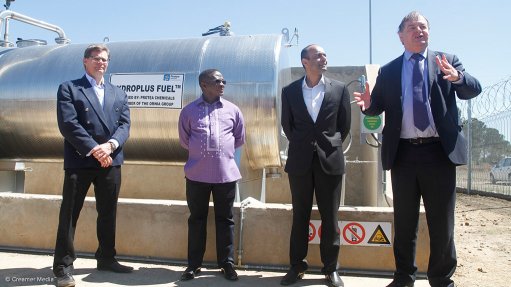
Amplats CEO's office: technical assistant Stephen Bullock, Mineral Resources Deputy Minister Godfrey Oliphant, Amplats market development principal Angelin Maharaj and Amplats technical and engineering consultant Clive Seymour
Photo by: Duane Daws
A methanol-based fuel cell rural electrification field trial by JSE-listed Anglo American Platinum (Amplats) with support from the departments of Mineral Resources, Energy, Science and Technology and Trade and Industry, Eskom and the Moqhaka Municipality has provided detailed data on the use of fuel cell microgrid systems to provide rural communities with electricity.
Three 5 kW fuel cells, a 73 kWh battery bank, a 14 m3 methanol fuel tank and inverters and control systems were used in the trial, which provided power to 34 households of the Naledi Trust community, in Maokeng township, in Kroonstad, in Free State, for 27 months.
Each household used its own television and radio and received electric appliances, including a fridge, a stove, a clothes iron and an electric kettle, from Amplats at the start of the trial to enable an accurate assessment of projected demand. Each house also has a prepaid meter and a “ready” board, which is a household distribution board that provides visual feedback for households to manage electricity use.
The data collected from instruments across the hybrid system and demand profiles are shared with all the departments involved and with academic and research institutions to enable more accurate demand modelling, planning and design.
The field trial provided invaluable data on the provision of basic electricity services to rural off-grid communities and typical demand patterns and consumption of electricity, Amplats market development principal Angelin Maharaj said on Tuesday.
The system produced an average of 35 MWh/y of electricity. However, Amplats technical and engineering consultant Clive Seymour noted that the lessons learned from the field trial would enable the company and its partners to design off-grid systems more accurately, and reduce the size of the overall system and capital and operational costs.
The methanol fuel was monitored remotely and deliveries of the methanol-water mixture were done on average every 34 days.
The methanol fuel mixture is subjected to steam reformation producing carbon dioxide (CO2) and hydrogen (H2) gas. This gas is then sent through a palladium membrane diffuser, which separates the CO2 from pure H2, which is then used by the fuel cells to produce electricity.
The field trial demonstrated the feasibility of providing basic electricity services to off-grid communities for household purposes. The deployment of fuel cell microgrids in rural communities also has the potential to supply electricity for small community businesses, refrigeration for vaccines and for irrigation in agriculture, noted Maharaj.
The benefits to the community from the trial included safe energy, owing to the elimination of wood, paraffin and candles, better lighting and a reduction in food waste owing to refrigeration, he highlighted. The community would be connected to the national electricity grid at the end of the trial in December.
Mineral Resources Deputy Minister Godfrey Oliphant, who had supported and championed the trial over the two-year period, lauded the work done by Amplats and its partners and reiterated the department’s support for fuel cell technologies and development of local industries, and specifically the beneficiation of local natural resources, such as the platinum-group metals that are central to platinum-based fuel cells.
The field trial used commercially available fuel cell systems, which are used to provide backup power for cellular telecommunications towers. However, these systems are not designed to be run continuously and better performance could be gained from fuel cells that are designed to operate continuously.
The trial used various control mechanisms that managed inverter utilisation and switched individual fuel cells on or off as required to charge the battery bank, and provided high quality data of hybrid microgrid design, management and scheduling, emphasised Seymour.